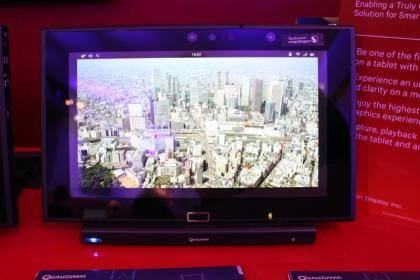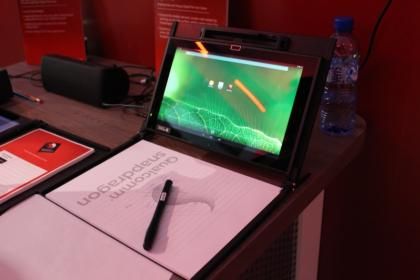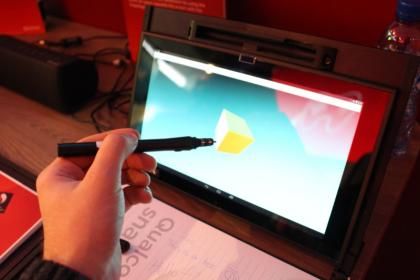We're still a long way from Qualcomm being ready to launch its latest flagship tablet processor onto the world, but that doesn't mean we can't get an early look to see what we can expect from Snapdragon 805. The 64-bit system-on-chip is already powering several reference devices on the company's Mobile World Congress booth, with some being used to power the world's first 10in tablets with a 4K Ultra HD resolution.
Comprised of four Krait 450 cores running up to a maximum 2.7GHz clock speed, paired with an Adreno 420 GPU and 128-bit memory interface, Snapdragon 805 will provide a significant performance increase over the outgoing Snapdragon 800 CPU. It flew through the games and apps we threw at a reference tablet, showing absolutely no signs of slowdown, lag or stutter as we opened and switched between several demanding games. The reference models were all running the latest 4.4 KitKat build of Android, and did so very smoothly.
This performance will be immediately noticeable in games; Depending on the type of workload, it could see performance improvements of up to 40% over the current Adreno 320. Fighting game Injustice looked incredibly smooth, even at 1080p, while a turn-based strategy demo produced some impressively detailed scenery that could easily rival some console games when it comes to texture and lighting effects.
Adreno 420 now supports hardware tessellation, a feature only recently incorporated into DirectX and available on both Sony's PS4 and Microsoft's Xbox One , meaning tablets will soon be even closer to desktop PCs and games consoles in terms of graphics potential.

4K Ultra HD resolution display on a 10in tablet - so fine you'll need a magnifying glass
It will also be able to drive 4K resolution displays. A single 4K reference tablet was on display, squeezing a 3,840x2,160 resolution panel into 10.1 inches of screen space. It's difficult to argue that this makes it one of the sharpest, most detailed tablet displays around, but we weren't as blown away as we have been by 4K content running natively on a 65in TV - you have to press your nose to the screen in order to spot the tiniest details that would otherwise be immediately noticeable on a larger screen. It's a technical achievement, but one we aren't sure is strictly necessary.

A more esoteric example of that power being put to use is with Qualcomm's ultrasonic pen technology. Using seven stereo microphones built into a reference tablet, the 805 is able to detect exactly where a stylus is within the 3D space in front of the tablet. The pen itself emits an ultrasonic pulse higher in frequency than the kinds that would bother your pets, changing frequency depending on the amount of pressure applied. That means you can take notes on a paper notepad, and have the text automatically recorded to your tablet as handwriting or converted to editable text using OCR. Because the tablet is aware of the pen's exact location and proximity, you can also use it to interact with on-screen objects, rotating, expanding and contracting them using all three axes.

The battery and cost saving implications for this technology are huge. As there's no need to add an expensive digitiser layer to a tablet touchscreen, manufacturers will be able to produce devices for less cash yet still boast about features like pressure detection in their marketing materials.
The system worked very well when writing in large, legible writing, but smaller details and sketches weren't picked up with exact accuracy. Even so, it's a very impressive prototype technology that could make its way into any device powered by a Snapdragon 805.
Based on what we've seen the Snapdragon 805 will be more than an incremental update. Expanded support for Ultra HD resolutions and 4K video playback will hopefully topple another obstacle and get the format off the ground, while any way to add features like stylus support without the need for expensive extra components will surely be welcomed by manufacturers. It's now just a question of when we'll see 805-powered devices on sale. According to Qualcomm the Snapdragon 805 has already been sampled to hardware manufacturers, so the first commercial devices should be available in the coming months.
